17 Easy Indoor Plants for Busy People

Unless you have severe allergies or pets that like to eat anything green, you’d probably love to have at least a few houseplants in your home. They brighten things up, add some natural color to the space, and can even help purify the air. But if you’re someone who barely has time to take care of yourself, becoming a plant mom or dad is probably the least of your concerns—which is why we consulted plant experts to get their list of indoor plants that are easy to care for. Keep reading for 17 low-maintenance houseplants that even the busiest folks can keep alive and thriving.
RELATED: 13 Low-Maintenance Outdoor Plants for Beginners.
1
ZZ Plant
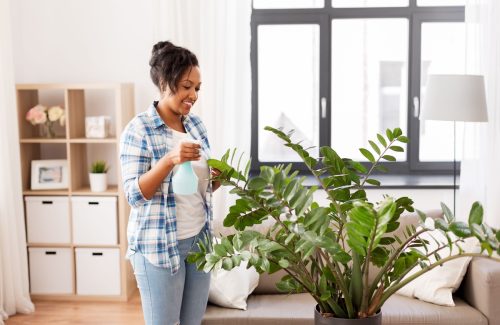
One of the most recommended houseplants for beginners is the ZZ plant or Zamioculcas zamifolia. It’s also known as the Zuzu plant, the Zanzibar gem, the emerald palm, and even the “eternity plant,” apparently because of its exemplary ability to evade death.
In fact, Anastasia Borisevich, plant expert at Plantum, an app that helps identify plants and improves plant care, calls these plants the “queens of easy maintenance.”
“They can handle prolonged dry spells and won’t freak out if you skip a watering,” she shares. “No sunlight? No problem: ZZ plants are known for their ability to survive even in rooms with no windows.”
Costa Farms horticulturist Justin Hancock adds that this indoor plant also tolerates low humidity, “so it shouldn’t get brown leaf tips, even if your furnace or fireplace is constantly going all winter.”
For something a bit more unique, Hancock suggests the Raven ZZ plant.
“Raven ZZ may be the ultimate houseplant in that it’s beautiful (it has lush, shiny leaves that emerge a dazzling shade of lime green and then transform to a sultry purple-black color) and ultra-easy to care for,” he says.
Regardless of their color, ZZ plants are so hardy that it’s not unusual for them to get quite large.
RELATED: 7 Popular Houseplants That Are Actually the Hardest to Keep Alive.
2
Tradescantia Zebrina
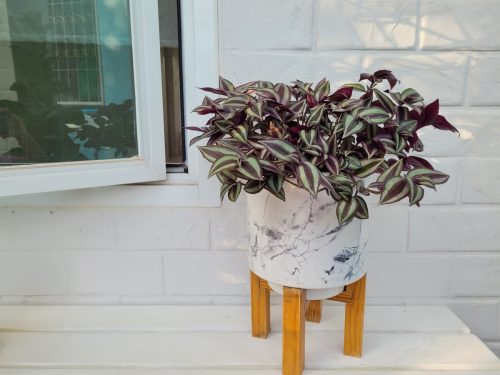
“Also known as the inch plant, Tradescantia Zebrina is a low-maintenance plant that grows well in low, indirect light and can still be successful when nurtured in a container with other plants,” says Rebecca Sears, CMO and resident green thumb at Ferry-Morse. “Be sure to keep the top inch of your plant’s soil moist, which can easily be determined by checking the soil with a moisture meter.”
She also points out that this is a great plant if you’re into the “goth gardening” trend, as its leaves “will bring striking green and dark purple tones to your space.”
3
Ponytail Palm
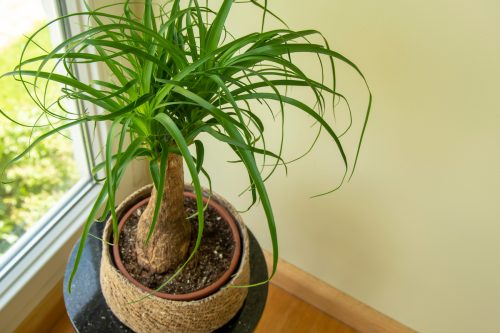
Hancock explains that the ponytail palm is native to the deserts of Mexico. It is an extremely drought-tolerant houseplant, storing water in its thick trunk.
This plant does best in bright light “but is pretty forgiving of lower light levels,” Hancock notes. “It loves average household temperatures and doesn’t mind low humidity—so all you need to do to enjoy it is give it a bright spot and water every week (or two),” he says.
4
Snake Plant
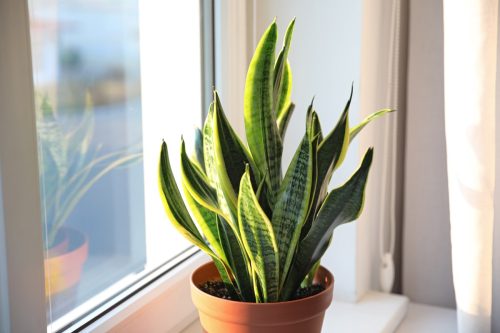
Along with the ZZ plant, snake plants are probably the most popular indoor plant for those without a green thumb.
So named for their tall, stiff, snake-like leaves, these plants “can thrive almost anywhere,” says Borisevich.
Though it does best if you water it regularly, Hackcok notes that the snake plant can handle watering as infrequently as once a month.
“It grows in low, medium, or bright light,” he says, adding that “it thrives in average household temperatures and tolerates low humidity levels.”
“It’s also uncommonly tolerant of being rootbound—so you don’t need to worry about it sulking if the roots fill up the pot,” Hancock points out.
RELATED: 10 Easy Hacks to Save Your Houseplants That Gardeners Swear By.
5
Peperomia
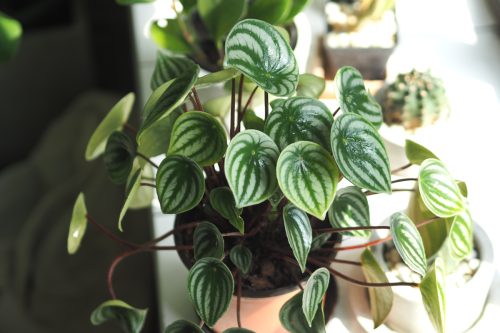
There are more than 1,000 recorded species of peperomia, including the popular red-edge and ripple varieties. Each one has a slightly different look, such as the watermelon peperomia, which features green leaves with white stripes, and the peperomia columella, which has downturned leaves with spiky tops.
While they all tend to be on the smaller side, they can grow to be about a foot wide and can thrive even in a dim room (though they can’t thrive in intense, direct sunlight, according to The Sill).
“Water every 1-2 weeks, allowing the potting soil to dry out between waterings,” advise the experts at The Sill. “Expect to water more often when your cactus is in brighter light and less often in lower light.”
Peperomia are also “resistant to most plant pests,” they say, and are non-toxic to pets.
6
Rubber Plant
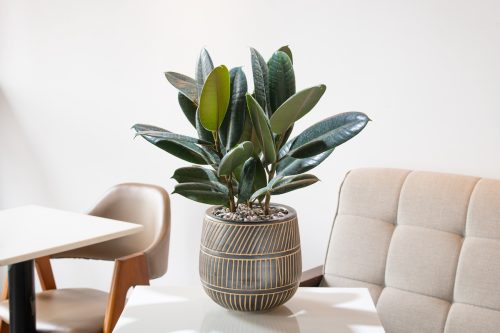
Alex Kantor, owner of Perfect Plants Nursery in Monticello, Florida, recommends the Ficus Elastica, or rubber plant, for busy people because it’s “a resilient plant that provides clear signs when it needs attention.”
“If the plant requires water, its leaves may droop, but they will visibly perk back up once properly hydrated,” he explains of the plant, which is one specific example of a peperomia.
Likewise, if it’s not receiving adequate light (it prefers medium to bright indirect light, according to The Sill), the color of its leaves will begin fading.
For something a little dramatic, Kantor is partial to the ruby rubber plant: “With its glossy, burgundy-colored leaves that have a waxy texture, the ruby variety adds a touch of elegance and drama to any indoor space.”
RELATED: 8 Houseplants That Improve Your Mental Health, Science Says.
7
Umbrella Plant
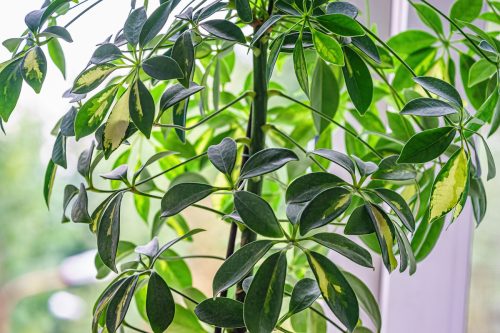
Formally known as Heptapleurum arboricola or schefflera, the umbrella plant gets its nickname from its long, rounding leaves that create a canopy-like effect.
“A 70s staple, these plants are good growers and can reach about six feet in the home,” shares Lisa Price, owner of Root Houseplants in Liverpool, U.K.
You’ll just want to position them in bright, indirect light and water them a few times a month (or when the soil has dried out).
8
Aglaonema “Silver Bay”
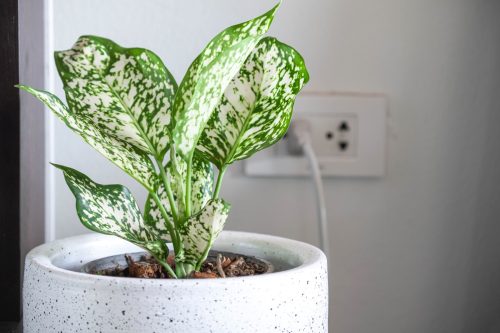
Also known as a Chinese evergreen, the Aglaonema “Silver Bay” plant gets its name from its luscious, light- and dark-silver-green leaves.
“It’s pretty drought tolerant; it can survive watering as little as once a month or so, but does much better when watered regularly—as the top half or so of the potting mix dries to the touch,” explains Hancock. “It holds up well to low humidity levels and loves average household temperatures.”
Vladan Nikolic, plant expert and founder of the houseplant care blog Mr. Houseplant, says the Chinese evergreen is also “extremely low-light tolerant, which makes it a perfect choice for rooms or offices that don’t get plenty of light.”
9
Hoya Carnosa
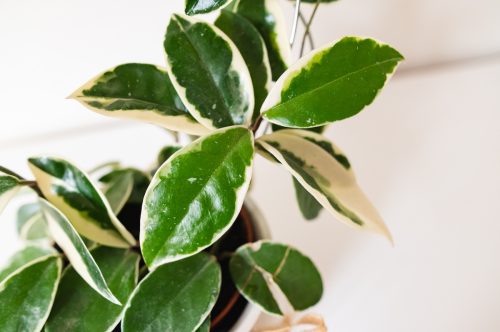
This slow-growing vine looks great in hanging baskets, cascading down a shelf or table, or trellised up the wall. Its pink and white flowers produce a beautiful chocolate-like scent.
Also referred to as the wax plant, “Hoya carnosa has thick, fleshy leaves, which allows the plant to hold on to moisture,” explains Price—which means it can be watered less frequently than other plants.
Another low-maintenance feature of the Hoya is that it’s epiphytic, so it “can tolerate staying in a smaller pot,” notes Price.
RELATED: The 5 Best Potted Plants for Your Front Porch, Gardening Experts Say.
10
Spider Plant
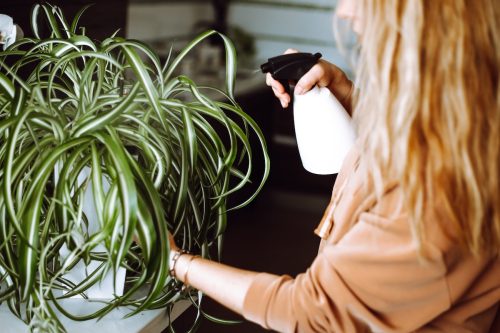
One more houseplant that looks beautiful in hanging planters is the spider plant.
“This houseplant is ideal for beginner gardeners, as they’re undemanding, can grow well in low-light conditions, and only need to be watered once per week,” explains Sears. “Don’t be concerned if your spider plant goes a few extra days without water or you can’t find a super sunny place to put it, as this plant is hard to kill, even in less-than-ideal conditions.”
Nikolic adds that spider plants can adapt to nearly any humidity conditions.
11
Monstera
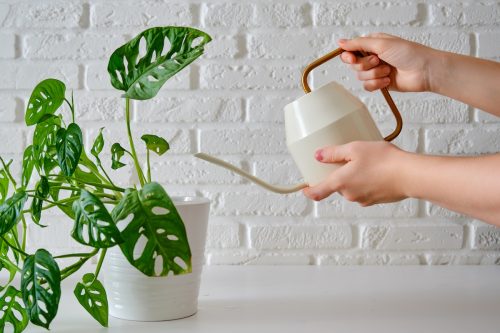
If you thought easy indoor plants couldn’t also be beautiful, then you haven’t met the Monstera. Affectionately called the “Swiss cheese plant” for its holey leaves, this houseplant is a favorite among social media plant-fluencers.
Borisevich says this is “a good low-maintenance pick for spacious rooms,” as they can grow up to eight feet tall. (Though keep in mind the stems will not grow completely vertical, so you don’t actually need ceilings this high.)
“Not too fussy about humidity, sunlight, or watering, the Swiss cheese plant can survive in a variety of conditions and even become a source of shade if you let it,” she adds.
12
Succulents
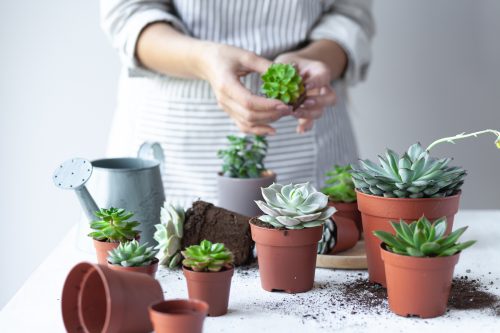
“Succulents are a popular houseplant not only because they come in a variety of shapes and colors but also because of their resiliency and how easily they grow regardless of droughts or poor soil,” notes Sears.
“They’ll thrive in full sunlight, so consider investing in a grow light if you plan on growing these indoors but live in a zone that doesn’t have optimal weather year-round,” she advises. “Avoid overwatering your succulents by letting the soil dry out before watering again, and be sure to plant them in well-draining soil so that the water can properly evaporate over time.”
It’s also a good idea to use a pot with a drain hole and set it on a saucer, or you can opt for a pot with a built-in drainage base.
Succulents are a great choice if you’re short on space and need plants that will stay small.
RELATED: 8 Indoor Plants That Keep Bugs Away, According to Experts.
13
Madagascar Palm Tree
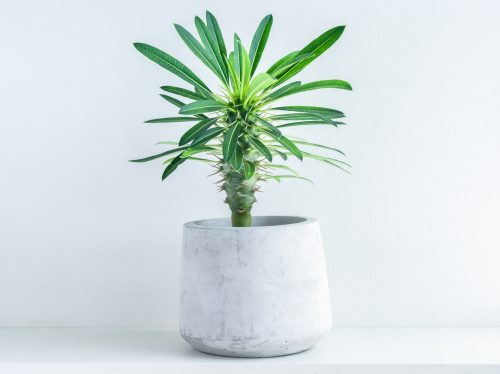
Despite its name, the Madagascar palm tree is not a palm but a succulent. The tropical-looking houseplant has flowing, palm-like leaves with a thick, spiny, cactus-like trunk.
“This hardy plant thrives with minimal care, requiring only adequate light—preferably full sun—and well-draining soil to prevent root rot,” notes Kantor. “It’s also quite drought-tolerant, needing infrequent watering, especially in the winter when it’s dormant.”
14
Cacti
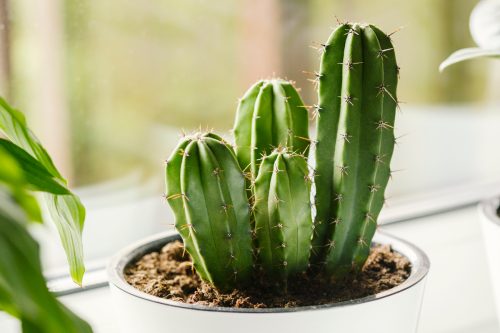
“Our rule when caring for cacti is ‘When in Doubt, Drought!'” share Brian and Emily Kellett, co-founders and owners of STUMP plant shops.
“People often forget where cacti are native to, such as deserts where rainfall is infrequent,” they explain. “So, as long as they are in a sunny, unobstructed window spot, they are easy to care for and only need to be watered once every few weeks for smaller cacti and monthly for larger cacti.”
15
Fishbone Cactus

Speaking of cacti, Price says the fishbone cactus is another easy houseplant.
“Disocactus anguliger is an epiphytic plant with thick, modified stems that have a zig-zag appearance,” she shares. “They grow upright and eventually begin to trail when gravity takes effect.”
“Water when at least half the potting mix is dry,” she advises. “They’re tolerant to average light conditions but do best in morning light.”
Price adds that fishbone cactus is incredibly easy to propagate: “Simply take a stem cutting and allow the end to dry for 24 hours, then pop into a small jar of water or into a small pot of soil.”
16
Aloe Vera
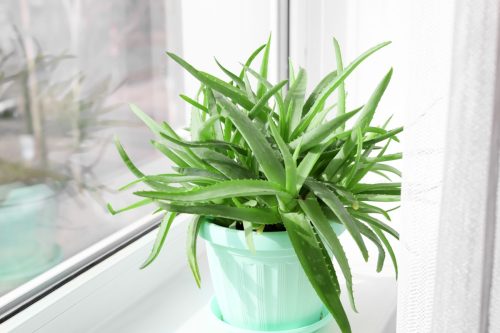
If you’ve ever applied aloe to a nasty scrape or sunburn, you know how handy it can be to own this particular succulent. But what you might not know is how easy it is to keep this plant alive.
Simply place the pot in a bright, sunny spot and water it whenever the soil gets dry—about once every two to three weeks, according to the Old Farmer’s Almanac. One of the quickest ways to kill your aloe plant is by overwatering it, so be sure that the soil has completely dried before watering.
17
Haworthias
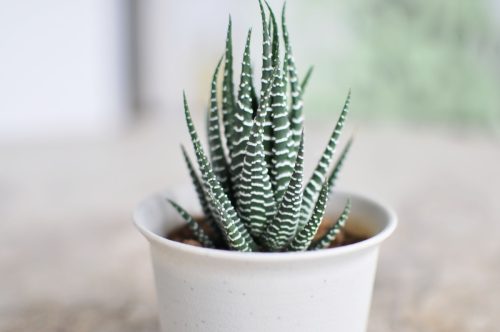
If you like succulents but don’t get a ton of natural light, the Kelletts suggest opting for Haworthias.
“These dark green, succulent-like plants are very easy to care for and don’t require as much sunlight as other succulents. We water ours every 2-3 weeks, depending on their proximity to a window,” they share.